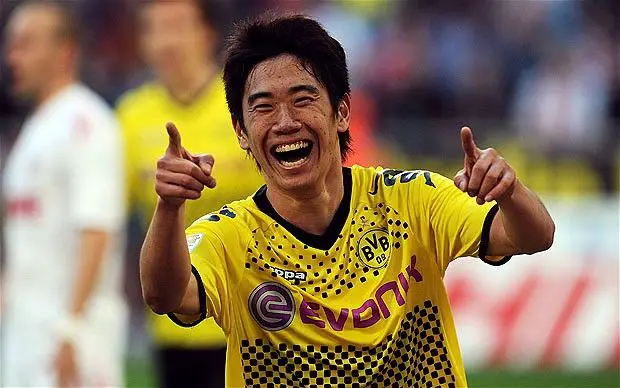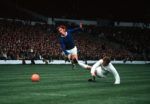Manchester United lost to Bayern over two legs in the Champions League quarter finals. Although the final scoreline of 3-1 suggests otherwise,the game was actually quite close until United scored the first goal. Shinji Kagawa who finally got a chance to play in a big game was one the few United players who impressed on the night. Now,we ll take a look back to Kagawa’s time with Borussia Dortmund to see why he was so successful back then.
From Osaka to Dortmund
Borussia Dortmund’s recuperation from a financial crisis at the turn of the millennium was close to complete. Jurgen Klopp was in charge of the club and the former Mainz man’s tactics were helping the Gelbe Wand bounce to the tune of victory once again. European football was becoming a dream, Lucas Barrios was turning into a prized possession and Klopp was clearly helping the team grow rapidly.
In the summer of 2010, a diminutive Japanese attacking midfielder was brought to the Signal Iduna Park with the hope of replacing Tamas Hajnal. And boy, did he replace the Hungarian!
Making his debut in Dortmund’s very first league game, along with a certain Polish striker remembered for massacring Real Madrid’s defense last season, Kagawa was unable to help his side from falling to a defeat against Bayer Leverkusen.
Sometimes it is losses like this that wake teams up, instilling a whole new sense of spirit and urgency. Dortmund went on a fifteen game unbeaten streak, with Kagawa playing an instrumental role in this run. Despite slotting behind the striker, Kagawa scored eight goals and provided one assist in this fifteen game stretch.
Kagawa’s crowning moment during this run came in his first ever Revierderby. The midfielder scored a brace within an hour to ensure that Dortmund left Gelsenkirchen with three points and was beginning to grow into a favorite among the Black and Yellow faithful.
Injury layoff and the return in 2011
Dortmund’s unbeaten streak was brought to an end by Eintracht Frankfurt and so was Shinji Kagawa’s season. With the Asian Cup set to take place in December of 2010, Kagawa was off on international duty during the winter break in Germany. After an impressive set of performances for the Japanese national team in the group stage and quarter finals of the Asian Cup, Kagawas suffered a metatarsal fracture in the semi final against South Korea.
The injury forced Kagawa out of action for the rest of the season, thereby ruling him out of Japan’s Asian Cup victory and also Dortmund’s Bundesliga triumph. There was growing skepticism regarding Kagawa’s ability to perform at the top level after such a long injury layoff. Could Klopp take the risk and hope that the returning midfielder would emulate his brilliance of the previous hinrunde, especially with Nuri Sahin having left for Real Madrid?
It was a risk that was surely worth taking. Kagawa hit the ground running, starting Dortmund’s first seven league games and also featuring in their first two Champions League games. Goals and assists were a little hard to come by during his first couple of months after returning from injury but Klopp’s faith and patience in the attacking midfielder paid good dividend.
Kagawa scored an incredible twelve goals and provided twelve assists in twenty four Bundesliga appearances, thereby ensuring that the magical Sudtribune was treated to a second consecutive league triumph.
Kagawa and Dortmund’s glories didn’t end just there in 2012 as they also lifted the DFB Pokal after thrashing none other than Bayern Munich in the final. The domestic double was the icing on the cake for both player and club, but also proved to be the final piece of silverware that they would earn together.
Kagawa departed for England in the summer of 2012, after enjoying two incredible seasons with Borussia Dortmund. Unfortunately for Kagawa, life in England hasn’t been easy. Having been deployed as an attacking midfielder, the typical number 10, Kagawa was also given a lot of freedom when it came to pushing into the penalty area and scoring. In some senses Kagawa qualified as a supporting striker. Given Dortmund’s gegenpressing and rapid counter attacking, Kagawa was allowed incredible freedom from a positional perspective.
The positional interchange between the three attacking midfielders in Klopp’s system was another feature that Kagawa adapted to very well during his two years at Dortmund. Quick one touch passing, coupled with a lot of off-the-ball movement by the attackers aided Kagawa’s game greatly as it allowed him to act as a pivotal point through the middle around which all moves were run.
At United, both under David Moyes and Alex Ferguson, Kagawa has not been given a role through the middle. Used primarily on the left, in a system that doesn’t rely on inverted wingers, the 25-year-old has greatly struggled. There have been moments of brilliance but Kagawa still hasn’t been given the freedom and positional consistency that he had at Dortmund. If the winds of change blow over both Moyes’ tactical mindset and Kagawa’s luck, both club and player may well be set for great heights once again.










Recent Comments